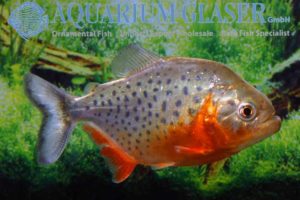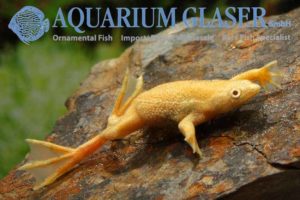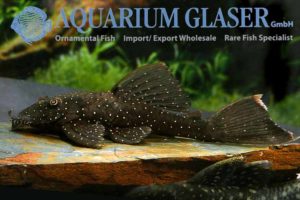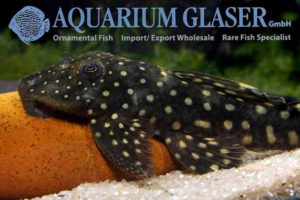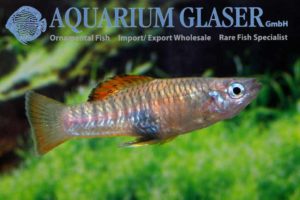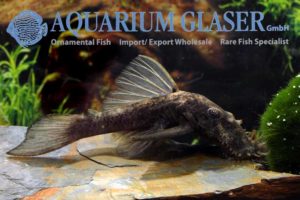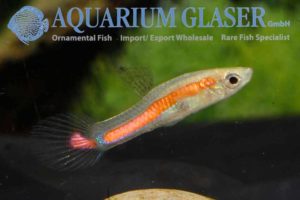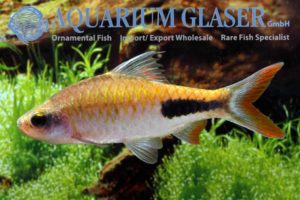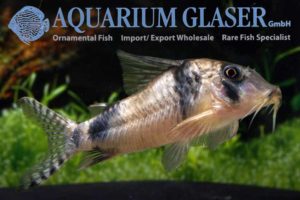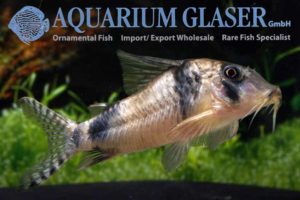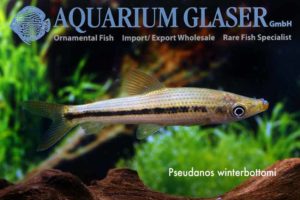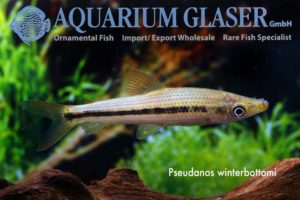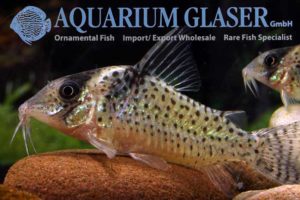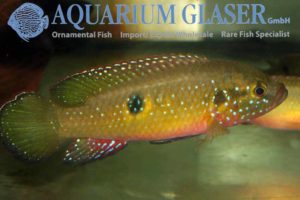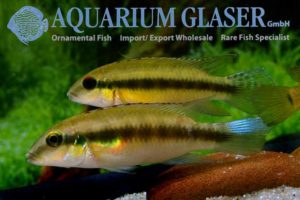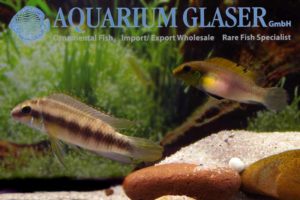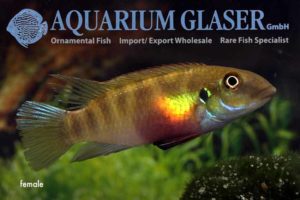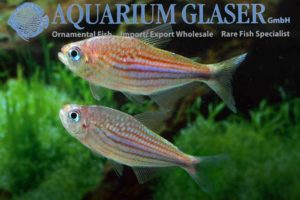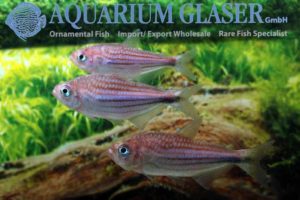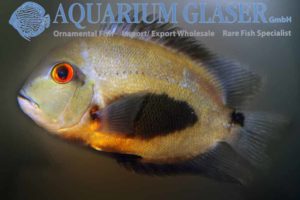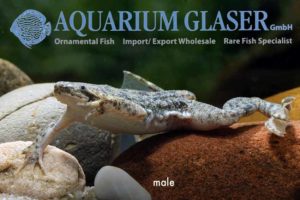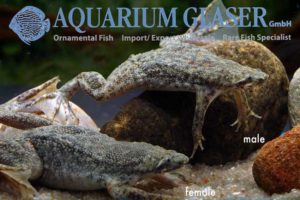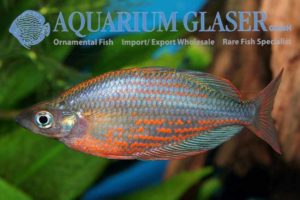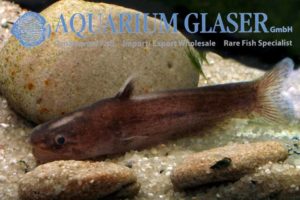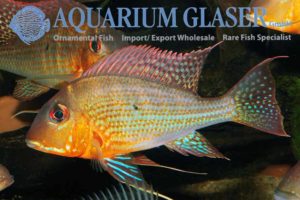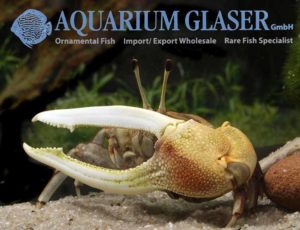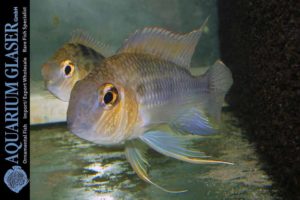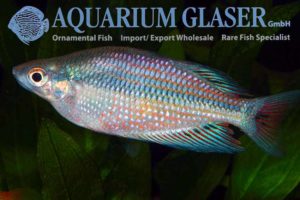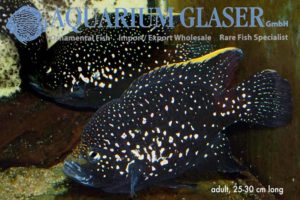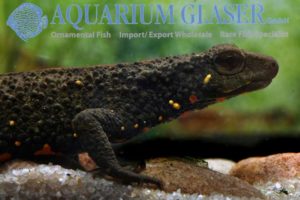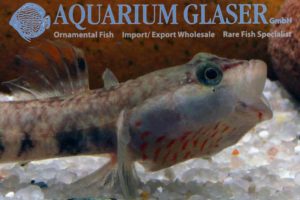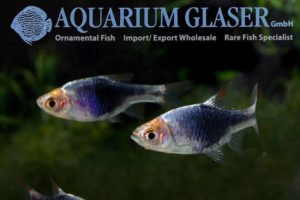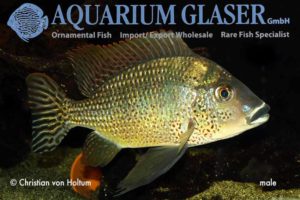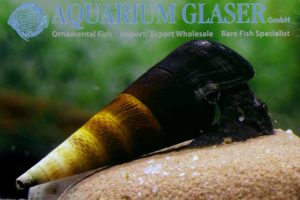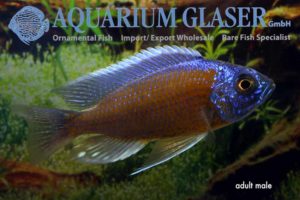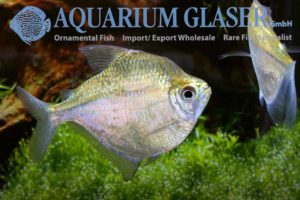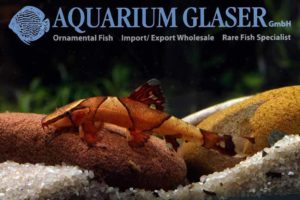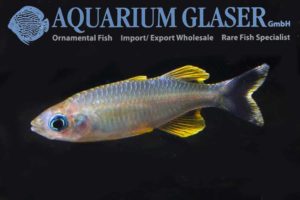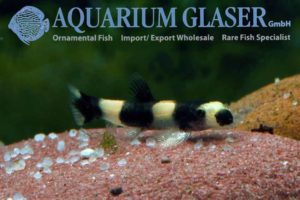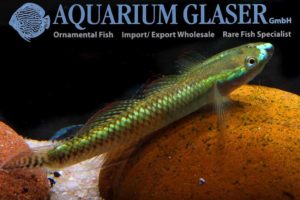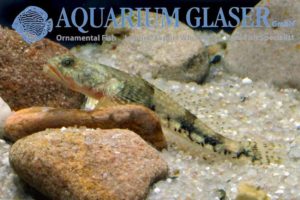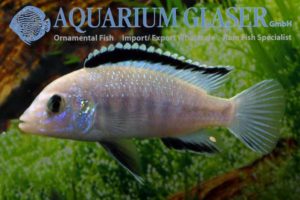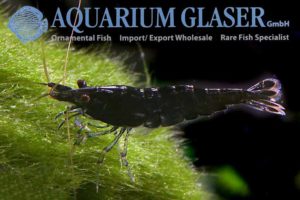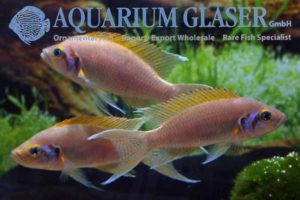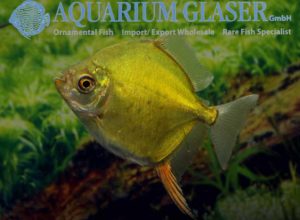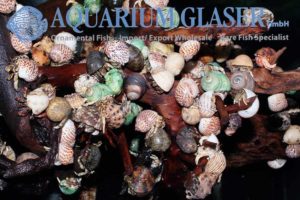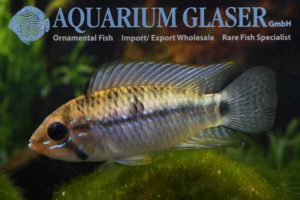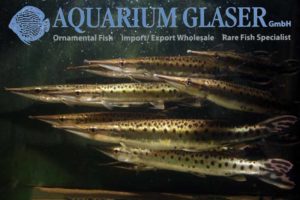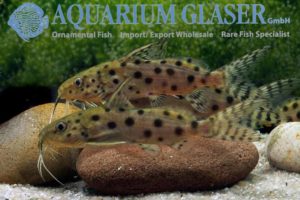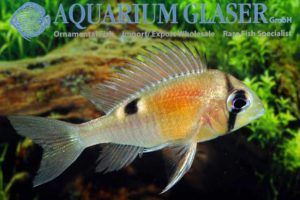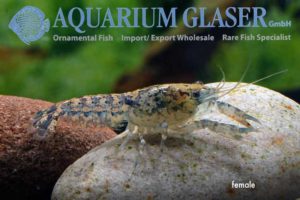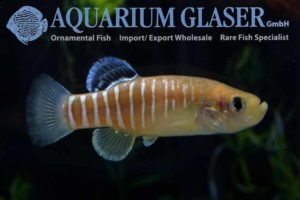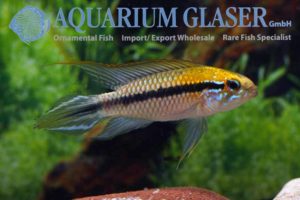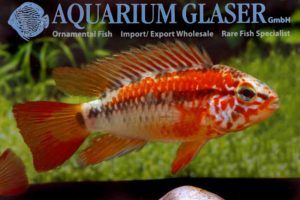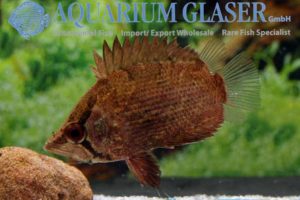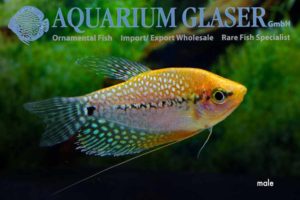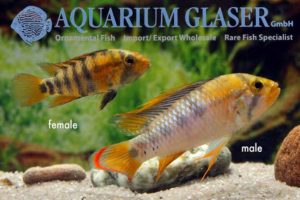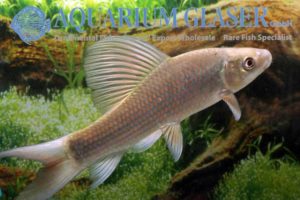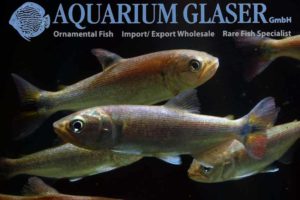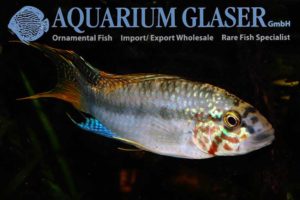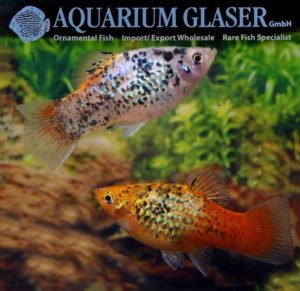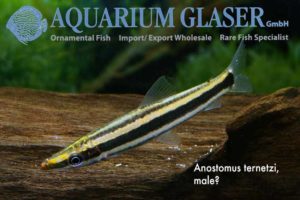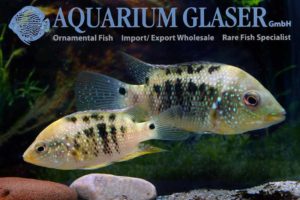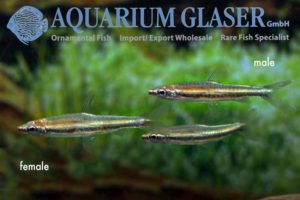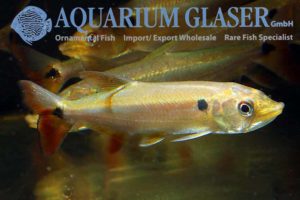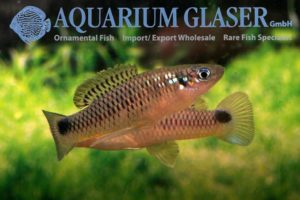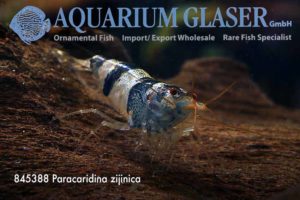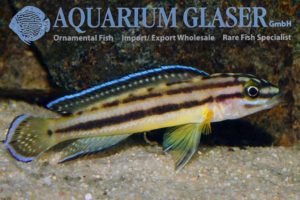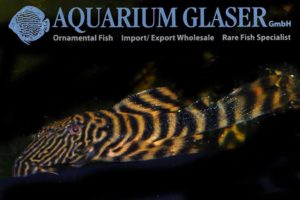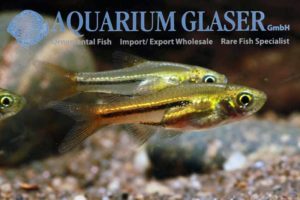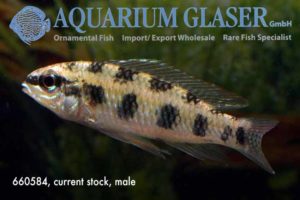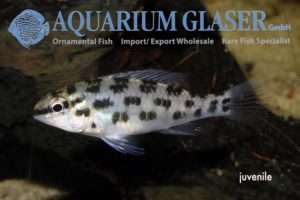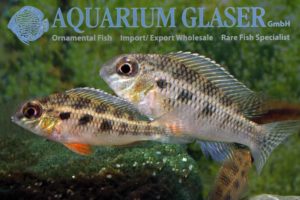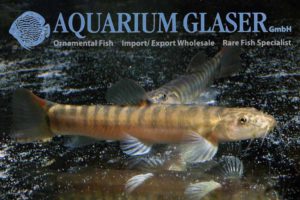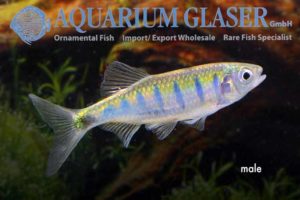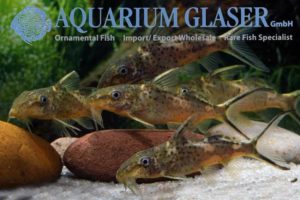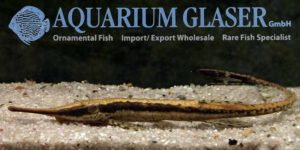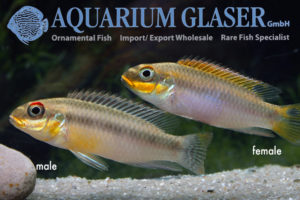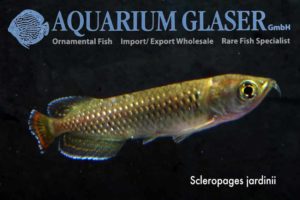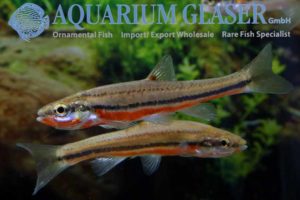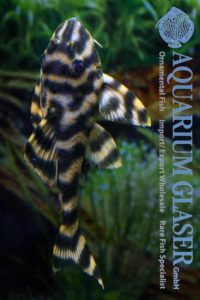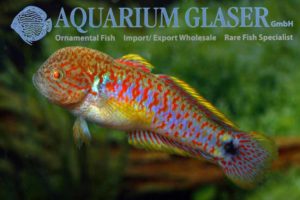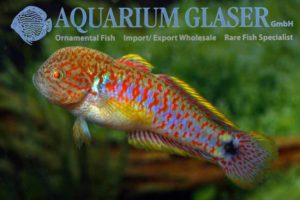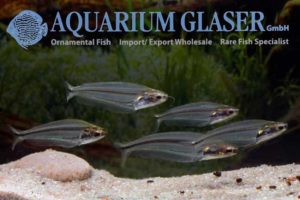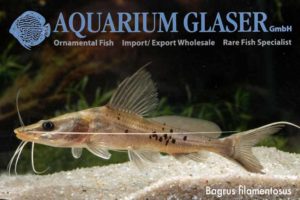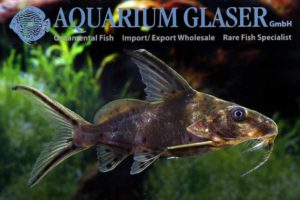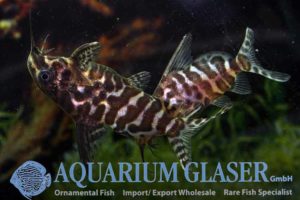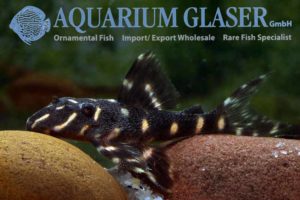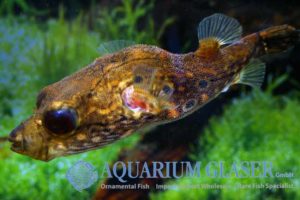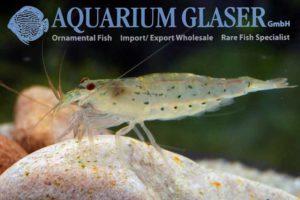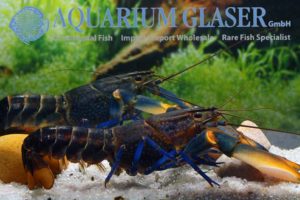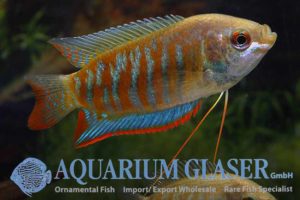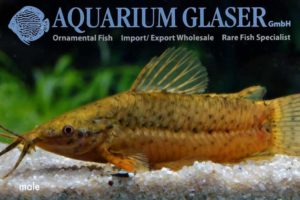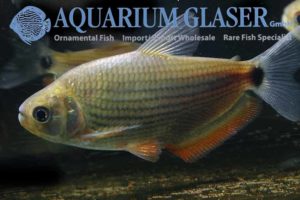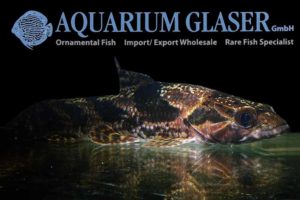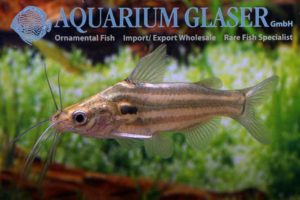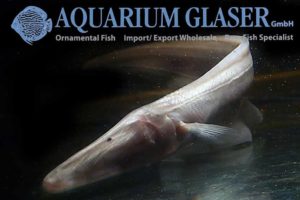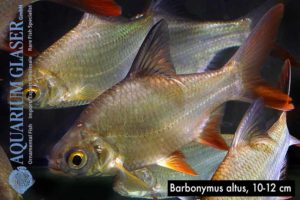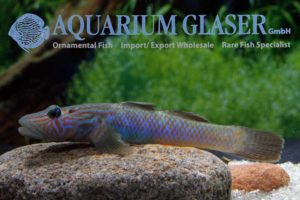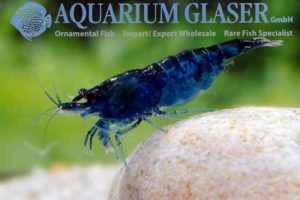The Red Piranha, Pygocentrus nattereri, is the only species of piranha that is bred on a commercial basis due to the high demand on these fishes in the ornamental fish trade. So it is always available in the shops and almost all of the offered fish are bred ones. Now we were able once more […]
Fish Archive (3096)
-
-
Hymenochirus boettgeri Gold-Albino
Hymenochirus boettgeri Gold-Albino The most popular of all underwater frogs is the Dwarf Clawed Frog Hymenochirus boettgeri. It is bred as an ornamental animal for years already. So it was only a matter time when albinos would appear in the market: and here they are! Really nice animals, aren´t they? For our customers: the frogs […]
-
Ancistrus sp. L181 Rio Negro
The many species of Ancistrus with small white dots are very difficult to tell apart. We recently obtained L181 from the Rio Negro in Brazil. The very same species has been given several L-numbers, eg L71 (from the Rio Tapajós) or L249 (from the Rio Trombetas and its affluent, the Rio Cuminá). Also extremely similar […]
-
Pseudancistrus sp. LDA 32/L259/L321 Rio Tapajós
Currently four syntopically occuring forms of Pseudancistrus are reported from the Rio Tapajós. They differ from each other by minor differences in respect of coloration and proportions. L321 is the comparatively flattest of them, has small dots and a reddish seam at the caudal fin. LDA32 and L259 are a bit deeper bodied and have […]
-
Brachyrhaphis roseni
Generally speaking, wild forms of livebearers are only rarely seen in the hobby. However, aquarists who specialize themselves in these fishes are most often that fascinated that they never give them up anymore. One of the most beautiful species is Brachyrhaphis roseni, which originates from brooks running through woodland in Panama and Costa Rica. Keeping […]
-
Ancistrus sp. Black Rio Negro (L88)
We received a good number of pure black Ancistrus from the Rio Negro. These have no clearly visible markings, except one: a deepblack spot on the basis of the dorsal fin. This somewhat unspectacular, but characteristic feature made finally the determation possible. Our fish belong to the species named “L88” or Anstrus sp. Black (the […]
-
Wild Guppy Rio Morichal
The wild guppy from the Rio Morichal in Venezuela is also known as “orange line” among the specialists for wild forms of livebearers. These fish are a very tiny and slender variety of wild guppy, but not an artificial sport. In contrast to other wild populations of the guppy this one is known to be […]
-
Dawkinsia rohani (formerly: Barbus or Puntius rohani)
Once more we were able to import this gorgeous, medium sized barb – it attains a length of 8-12 cm – from southern India. For more informations on the species seehttp://www.aquariumglaser.de/en/fish-archive/barbs-asboras-danios-en/Dawkinsia_formerly_Barbus_rohani_en/. The photos show a mating male (recognizable by the tubercles on the snout and the red caudal fin) of our current importation. For our […]
-
Corydoras sp.
Another extremely rarely imported Corydoras species reached us from Peru. The unusual popular name of the scientifically undescribed species is due to the coloration, especially the dark triangle in the neck. This reminds one very much to the odd type of headdress worn by Gustaf Gründgens in his legendary production of Goethe´s Faust, where he […]
-
Corydoras sp.
The longsnouted and saddle-nosed Corydoras appear in the wild either solitary or in small schools. This is the reason why they are much more difficult to collect than the round-nosed Corydoras which most often live in very large swarms. This fact makes the longsnouted and saddle-nosed Corydoras much more expensive and also more desired by […]
-
Pseudanos winterbottomi
Code 283742 Photos: Frank Schäfer
-
Pseudanos winterbottomi
We received this nice headstander in the past years only very occasionally in single specimens as bycatch from Venezuela. Most often the specimens were intermixed in shipments of Anostomus ternetzi or Pseudanos trimaculatus. Finally we were able to import directly a number of the beautiful species. Pseudanos winterbottomi can reach a length of about 15 […]
-
Corydoras crimmeni
For the first time ever we can offer this beautiful Corydoras. It originates from the Rio Negro basin in Brazil. A bright green shine on the flanks of the body is very obvious, especially when the light falls from ahead on the fish. This species attains a maximum length of about 6.5 cm. For our […]
-
Hemichromis letourneauxi
Our current import from Guinea contained also two “classical” red jewel cichlids. They were sent under the names of H. letourneauxi and H. cristatus, respecively. Initially we fully agreed with those determinations. The H. letourneauxi showed all features typical for the species, eg the comparatively elongate body and the lateral spot placed comparatively far in […]
-
Pelvicachromis humilis and close relatives from Guinea (3): Pelvicachromis humilis SIERRA LEONE & P. signatus
In this very attractive variety both sexes have a bright yellow basic colour. In males, the caudal fin is spotted, ventral fins and anal fin are red. An unique feature for this form is the eye. The upper half of the iris is bright red in males and brass in females! For our customers: the […]
-
Pelvicachromis humilis and close relatives from Guinea (2): Pelvicachromis humilis DIKINYAH and FALESADE
This variety has the following characteristics: in males, the caudal fin is yellow without any pattern, the ventral fin blue and the dorsal fin has a red border. The horizontal stripe seems to be composed of spots. The dorsal fin of the female is bright yellow and has black spots in the upper backward part […]
-
Pelvicachromis humilis and close relatives from Guinea (1): Pelvicachromis humilis LIBERIA RED
Our current import from Guinea contains five different species/morphs of the relationship of Pelvicachromis humilis. They all have in common that the males can reach a maximum length of 12 cm. Females always stay smaller. The latter are the more colorful animals, there is always a clearly marked sexual dichromatism. During mating and displaying the […]
-
Moenkhausia agnesae
We received this wonderful tetra from Peru. Moenkhausia agnesae is only very rarely available. The species attains a maximum length of about 8 cm. One should keep this tetra, which is sometimes a bit quarrelsome, alnong with other medium sized tetras, cichlids etc.. Our imported fish have almost show size and show breathtaking colours. For […]
-
Moenkhausia agnesae
We received once more fantastic large Moenkhausia agnesae from Peru. This is a larger species that can be kept ideally along with cichlids and catfish. Maximum length reported from M. agnesae is about 8 cm. Formerly this species has been often confused with M. simulata. However, the horizontal stripes in M. simulata are all black, […]
-
Uaru amphiacanthoides SANTAREM
Once more we were able to import four wonderful specimens. They have 16-20 cm total length. One specimen, most probably a male, is obviously in mood for breeding: it reacts quite harsh against the photographer! For our customers: the fish have code 688496 on our stocklist. Please note that we exclusively supply the wholesale trade. […]
-
Pipa parva
The Dwarf Suriname Toad from Venezuela is a real rarity in aquaria. We have a new breeder that is able to offer us some specimens every now and then. At the first glimpse they nice animals remind one on Dwarf Clawed Frogs (Hymenochirus). However, like all other Pipa species, P. parva has ramifications on the […]
-
Pipa parva
The Dwarf Suriname Toad from Venezuela is a real rarity in aquaria. We have a breeder that is able to offer us some specimens every now and then. At the first glimpse they nice animals remind one on Dwarf Clawed Frogs (Hymenochirus). However, like all other Pipa species, P. parva has ramifications on the top […]
-
Glossolepis dorityi „Lake Nenggwambu“
Glossolepis dorityi also originates from West Papua, like Melanotaenia rubrostriata „Dekai Village“ (see http://www.aquariumglaser.de/en/news/Melanotaenia_rubrostriata_Dekai_Village__en/). Males attain a maximum length of about 15 cm, females stay smaller. Sadly the females have only quite dull colours. Males need about one year to reach a length of 7-8 cm. At that size they already display a real firework […]
-
Denticetopsis seducta
For the first time ever we could import this dwarf whale catfish from Peru. The maximum length of this tiny species seems to be around 5-6 cm. In contrast to the better known blue whale catfish, Cetopsis coecutiens, which is an aggressive predatory species, all Denticetopsis are competely harmless insectivorous fishes. This species has been […]
-
Geophagus cf. altifrons „Rio Araguari“
At the first glimpse one would doubtless place this fish to G. altifrons. However, there are differences. Up to a length of about 10 cm this new variety exhibits exclusively a pattern of vertical double-bars and has a comparatively large lateral spot. The dark zone between operculum and lateral spot, which is so characteristic for […]
-
Uca vocans
Fiddler crabs are always something very special. They live along the border of water and land. During the tide they hide in wholes in the sand. At low water the come out of their hiding places and search for food that the water left behind. The males display their mighty claw to impress the females, […]
-
Crenicara cf. punctulatum Lake Tapana
It was only quite recently that we were able to import Crenicara puntulatum from Peru. We reported on that importation here: http://www.aquariumglaser.de/en/news/Crenicara_punctulatum_Checkerboard_cichlids_part_1_en/. Now we received fully grown specimens from Brazil with an information on the collection site: Lake Tapana. These fish differ in some points from all so far described populations of Crenicara punctulatum. The […]
-
Melanotaenia rubrostriata „Dekai Village“
The village named Dekai is located in West Papua (formerly: Irian Jaya) in the district of Yahukimo. It seems to be a real hotspot for extremely beautiful species of rainbowfish. Many species and local varieties have been collected there in the past years and brought to the tanks of enthusiasts. This applies also for this […]
-
Paratilapia polleni
Many of the endemic species of cichlid from the island of Madagascar are endangered of extinction. This is due to destruction of the natural environments and the release of foreign fish species for food purposes. Sadly most of the Madagascar cichlids could not yet established as aquarium fish. An exception from that rule is the […]
-
Paramesotriton chinensis
Springtime is the time for amphibians. In Germany toads, frogs, and newts leave their winter lairs and turn back to the ponds where they have been born to spawn. The very same happens in other parts of the world that have a similar climate. So we now get newts from China sometimes. Paramesotriton chinensis is […]
-
Rhinogobius duospilus (= R. wui)
Gobies become more and more popular in the hobby. A real classic is R. duospilus, which was known under the name of R. wui for a long time. Nowadays R. wui is considered to be a synonym of R. duospilus. This small goby becomes only 4 cm long. In the wild it lives in brooks. […]
-
Trigonostigma heteromorpha Blue and Gold
The Harlequin barb (Trigonostigma heteromorpha) belongs to the most popular ornamental fish worldwide. The beautiful colours and the peaceful mood make them ideal inhabitants of a community tank. One can hardly believe today that once it was impossible to breed that species. In the 1930ies the breeders hard to learn that water chemistry can be […]
-
Tylochromis cf. lateralis German bred
For the first time ever we can offer German bred specimens of this beautiful and unusual large cichlid. The parents have been imported from the Congo. Keeping and breeding were successful under the following conditions: total hardness 14°, pH 7. The sexes show a clearly visible sexual dimorphism at an age of about 1.5 -2 […]
-
Faunus ater CAPUCCINO
This attractive, about 6 cm long snail currently reached us from Indonesia. It is a relative of the well known Malayian trumpet snail. In the wild this animal occurs in the lowest reaches of rivers on muddy bottoms and is thus very tolerant against salt. So it is possible to keep it in freshwater tanks […]
-
Copadichromis borleyi Kadango Red Fin
Copadichromis borleyi is a species of cichlid that inhabits Lake Malawi. It is found there pretty widespread. Males obtain a maximum length of 18 cm, females stay smaller and become only 15 cm long. The addition “Kadango” to the scientific name refers to a place in the south-east of Lake Malawi. Copadichromis are planctivorous fishes […]
-
Poptella paraguayensis
An ornamental fish has not be necessarily colourful to be a beautiful aquarium inhabitant. At least it is hard to believe that anyone would keep Discus tetras due to their colours. There are several species of Discus tetra, all quite similar to each other. We were now able to import one of them, Poptella paraguayensis, […]
-
Homaloptera parclitella
Hillstream loaches are – in general – rather dull coloured fishes. However, there are exceptions and among the most beautiful species are those belonging to the genus Homaloptera. Several, closely related and quite similar species exist. In German they are called “saddle-back loaches”, a commonly used English name is “lizard loaches”. For the first time […]
-
Telmatherina bonti (2)
The Malili lake system on Sulawesi (former Celebes) is home of spectacular shrimps, snails and mussels which are exported for the hobby. Now the import of an endemic atherinoid species was successful, namely Telmatherina bonti. Like many atherinoides of the Malili lakes this species is polychromatic, which means that males and females appear in different […]
-
Protomyzon pachychilus – season for Panda loaches!
The extremely charming juveniles of the Panda loach are available only a few weeks per year. Obviously this year was a good one for the fish and they have bred very successful, because a comparatively large number of specimens is offered for comparatively low prices. Among the good number of specimens we were able to […]
-
Stiphodon atropurpureus
The neon gobies of the genus Stiphodon are all very beautiful fishes. None of the currently known 33 species becomes larger than 5-7 cm, most of them stay much smaller. Despite the fact that adult Stiphodon live exclusively in pure freshwater the larvae can develop only in marine waters. This is the reason why species […]
-
Schismatogobius roxasi
The genus Schismatogobius contents currently 10 described species. All are small, only 3-5 cm long pure freshwater inhabitants. As no species is of commercial value and the tiny fish burry themselves extremely fast in the sand when disturbed the whole genus is only very unsatisfyingly researched so far. Two species have been reported fromTaiwan: Schismatogobius […]
-
Labidochromis caeruleus WHITE
Labidochromis caeruleus is among the most popular cichlids from Lake Malawi. Usually a bright yellow sport of that fish is available in the hobby. Only comparatively recently a white sport of the fish appeared in the ornamental fish trade. It is not an artificial sport, but a variety that is found in the wild. The […]
-
Neocaridina davidi Black Choco Shrimp
The most popular and easy to keep dwarf shrimp for the freshwater aquarium, Neocaridina davidi, has another new dress: pitchblack! Of course there do exist already black sports of other species of dwarf shrimp, but N. davidi has against other species the big advantage that N. davidi is extremely tolerant against different temperatures. Other species […]
-
Neolamprologus pulcher
Deep inside of even the straightest democrat seems to live a small royalist. How can it be explained otherways that extraordinary beautiful species of ornamental fish so often get royal popular names? The first Neolamprologus with a lunate tail fin with long filaments was imported around 1958. It very soon was called the “Princess of […]
-
Myleus sp., second take
Last week we informed you about the silver dollars we imported which exhibit an unbelievable green coloration. Here we present to you again pictures, but this time take from the now settled down specimens. They do belong without any doubt to the genus Myleus. Three species of Myleus are reported so far from Peru: Myleus […]
-
Coenobita rugosus
From Taiwan we were able to import beautiful land hermits. They belong to the species Coenobita rugosus, which can be recognized by the ridge-like swellings on the upper edges of the claws. The colour is very variable and can be grey, brown or reddish. Like all Coenobita species the animal likes to live in groups. […]
-
Apistogramma rupununi
Finally we were able to import again this dwarf cichlid after quite a long time. Most probably our specimens originate from Amapá in Brazil. It is quite tricky to distinguish A. rupununi from A. steindachneri in small wild collected specimens. However, our recently imported fish are quite large already (some males are already about 5 […]
-
Boulengerella maculata
The Spotted Pike Characin, Boulengerella macaulata, belongs to the most popular species of predatory fish in the freshwater aquarium. This has several reasons. First of all the up to 30 cm long species is very peaceful. All other tankmates (as long as they don´t fit the mouth) are simply ignored. And, despite the fact that […]
-
Synodontis ocellifer
This is another catfish-beauty originating from Nigeria. Someone once said that this species of Synodontis can be characterized by three adjectives: peaceful, beautiful, and hardy. In fact S. ocellifer is one of the most peaceful species of Synodontis at all. The maximum length of S. ocellifer is about 20 cm. When they get older they […]
-
Biotodoma cupido COARI
Coari is one of the largest cities in the Brazilian state of Amazonas. From the hobbyist´s point of view, Coari is famous for its wonderful Green Discus. Now we received for the first time ever Biotodoma from Brazil which were said to have been collected nearby Coari. Even immediately after the importation the fish showed […]
-
Cambarellus diminutus
We received nice bred specimens of this tiny species from Indonesia. Initially Cambarellus diminutus originates from North America, where it occurs along the Gulf of Mexico. In contrast to the larger species of crayfish, the species belonging to the genus Cambarellus fit perfectly for community tanks. C. diminutus is the smallest species of all and […]
-
Aphanius vladykovi BOLDAJI
Members of the killifish-genus Aphanius appear only in Europe, North Africa, and Asia. In the aquarium hobby they are really rarely seen, and can be hardly ever found in a regular pet shop. Sadly many of the currently 22 accepted species and subspecies are in danger of extinction due to habitat destruction. This is a […]
-
Apistogramma gephyra Bred
Do you know the difference between Apistogramma gephyra and A. agassizii? No? Well, you are in good company with that! Both species are really difficult to tell apart. They also appear at least in some places together in the natural habitat, so the origin is of no help. Both species never hybridize in the wild. […]
-
Apistogramma viejita Variety II
Apistogramma viejita originates from Colombia. However, in the ornamental fish trade almost exclusively bred specimens can be found. There do exist several varieties even in the wild, which differ mainly in coloration (especially the content of red is very different), but also in respect of the development of the dorsal and caudal fins. Sadly the […]
-
Polycentropsis abbreviata
Polycentropsis abbreviata means roughly translated “short and similar to Polycentrus”. In fact the African Leaffish looks very similar to Polycentrus schomburgkii from South America. Both species witness the existence of the ancient super continent Gondwana. Gondwana was formed from what is now South America, Africa, India, Australia, and Antarctica. South America drifted away from Gondwana […]
-
Trichogaster leerii GOLD
The pearl gourami (Trichogaster leerii) has not been bred in different sports yet, most probably because the wild type already represents one of the most beautiful species of fish at all. But now we received for the first time a golden (lutino) sport and we have to say that this variety really has a lot […]
-
Apistogramma baenschi (= Inka I)
Apistogramma baenschi from Peru is for sure among the most beautiful species of dwarf cichlid. The male combines splendid colours (especially the wonderful caudal fin) with a fantastic high dorsal fin and the female is also a real eyecatcher due to its unique tiger pattern. Currently we have both wild collected and bred specimens in […]
-
Labeo coubie
The great variety of species of Labeo from Africa is hardly known in the hobby. Even for scientists the determination is difficult. Only in 1990 a new species was detected in the Niger basin! This brings the number of Labeo-species known from the Niger to four: Labeo parvus, L. roseopunctatus, L. senegalensis, and L. coubie. […]
-
Salminus arrived!
The genus Salminus currently comprises four species. These tetras can become very large. The most colorful of them is S. brasiliensis, also known as “Dorado”. Old fish get a breathtaking beautiful golden colour all over the body. This species is also known under the old, invalid name S. maxillosus. The species can become one meter […]
-
Apistogramma sp. Diamond Face
We received some German bred specimens of that rare Apistogramma from one of our breeders currently. Initially this fish was imported in 2009 It was said to originate from the Rio Jutai in Brazil, a left hand affluent to the Amazon river (which is called Solimoes there). Since then to the best of our knowledge […]
-
Platy Pepper & Salt Rainbow
We start in the new week with an extremely pretty salt & pepper sport of the platy. Each individual has a somewhat different colour. Some are rather red, other rather blue, most are a mix: rainbows! This new sport is a real and beautiful enrichment of the assortment! For our customers: the fish have code […]
-
Anostomus ternetzi
The golden striped headstander, Anostomus tenetzi, has a very wide distribution in South America. It is recorded from Brazil, French Guyana, Guyana, Suriname, and Venezuela. The specimens on which the original descritption based, originated from Venezuela, and we were able to import them from there once more. This beautiful fish is among the most peaceful […]
-
Cichlasoma ornatum
Does something like mythical fish still exist? If so, Cichlasoma ornatum from Colombia and Ecuador for sure belongs to that category. Despite the fact that the species is known to science since 1905 already, only very few specimens ever swam in the tanks of enthusiasts in Europe and the US. Most probably not even a […]
-
Nannostomus marylinae Venezuela
We could import a beautiful, only very rarely available species of pencil fish from Venezuela: Nannostomus marylinae. Some days after their arrival the fish showed two remarkable, reddish-brown spots in the middle of the body, a coloration that is said to be typical for N. minimus. However, now the fish have lost those spots. We […]
-
Acestrorhynchus altus
We obtained most beautiful barracuda tetras from the state of Para in Brazil. They look very similar to the fish we sometimes get from Paraguay. However, the species from Paraguay has been described scientifically as Acestrorhynchus pantaneiro, whereas the type locality for Acestrorhynchus altus is in the state of Para, Brazil. If Acestrorhynchus pantaneiro and […]
-
Pseudoxiphophorus anzuetoi
We can offer for the first time ever a very unusual livebearer: Pseudoxiphophorus anzuetoi. Possibly the specimens we currently have in stock are even the first ones traded ever worldwide. This species has been placed formerly (like all other species of Pseudoxiphophorus) in the genus Heterandria due to anatomical reasons. Funny enough, this led to […]
-
Mustang shrimps arrived!
For the first time we can offer the very pretty, black-and-white “Mustang Shrimp”. The dwarf shrimps belong – according to the “godfather of dwarf shrimps”, Werner Klotz – to the species Paracaridina zijinica. Regarding keeping and breeding they do not differ from the well known dwarf shrimp “Crystal Red”. By the way: this species of […]
-
Julidochromis marksmithi
The cichlids of the genus Julidochromis are among the most popular species of cichlid from Lake Tanganyika. Until recently five different species have been recognized. All of them are kept and bred in home aquaria. These are J. dickfeldi, J. marlieri, J. ornatus, J. regani, and J. transcriptus. The most recently described species of those […]
-
Panaqolus sp. Alto Nhamunda
Along with the spectacular Peckoltia sp. “Alto Nhamunda” (see http://www.aquariumglaser.de/en/news.php#1245) a specimen of Panaqolus reached us, which is very similar to the L-number L374. Very similar is also L403. Both L-numbers most probably represent the same species. One should not forget that a L-number is not given for new species, but for Loricariids exported from […]
-
Trigonostigma somphongsi
The Siamese Dwarf Rasbora (Trigonostigma somphongsi, formerly Rasbora somphongsi) has been described scientifically in 1958 on the basis of specimens that were imported by the ornamental fish trade by the end of 1957 from Thailand. So the exact type locality was unknown from the beginning. In the original description nothing but “Thailand” was mentioned, later, […]
-
Dicrossus maculatus – Checkerboard cichlids part 3
This splendid dwarf cichlid is known to science since 1875, but almost never found in home aquaria. This is a great pity, because there are hardly any species that are as beautiful as this one and simultaneously as peaceful! Males become around 9 cm long, females about 6 cm. The animals we currently have in […]
-
Dicrossus foirni (= sp. Rio Negro): checkerboard cichlids, part 2
Finally Dicrossus foirni is available again! This extremely rarely imported dwarf cichlid was formerly known in the hobby under the name of Dicrossus sp. “Rio Negro”. These fish are a real eyecatcher when fully grown. Keeping this jewel is not complicated at all, but for breeding extreme water conditions are necessary (pH below 5, hardness […]
-
Crenicara punctulatum – Checkerboard cichlids, part 1
Currently we have several species of checkerboard cichlids (genera Crenicara and Dicrossus) in stock. Most of them are real rarities in the hobby, among them Crenicara punctulatum. We obtained this pretty species from Peru. Males of Crenicara punctulatum can attain a maximum length of about 12 cm, so this species is not a dwarf cichlid […]
-
Schistura spilota
The loaches of the genus Schistura are spread all over South and Southeast Asia. They have much in common with the catfishes of the genus Corydoras from South America: they are present everywhere and there does exist a large number of species. Schistura spilota from Thailand is one of the largest species at all and […]
-
Opsarius bernatziki
For the first time ever we could import this pretty barb from Thailand. At first we thought the fish would belong to the species Opsarius ornatus, but after they has settled all of our fish showed a clearly marked caudal spot, which is typical for O. bernatziki, but lacking in B. ornatus. Another very similar […]
-
Synodontis sorex
Two weeks ago we presented to you some species of catfish we imported from Nigeria. This wonderful shipment contained also some by-catches, which are species that were send erroneously along with the ordered specimens. One of these by-catches came with Synodontis clarias. It was the extremely rarely imported species Synodontis sorex. This “Scissortail-Squeaker” has a […]
-
Farlowella vittata
The needle suckers of the genus Farlowella are quite specious. To date 27 species are recognized as valid. As many species look very similar to each other the exact determination often proofs to be quite difficult. The 27th species has been described very recently from Colombia (it is the species Farlowella yarigui which has not […]
-
Pelvicachromis taeniatus
Once more a change of names of well-known aquarium fishes appeared. The different forms of Pewlvicachromis taeniatus have been regarded for decades as mere colour varieties of the very same biological species. But now a new study has been published which laces almost all “varieties” from Cameroon under the taxon Pelvicachromis kribensis. Only one “variety” […]
-
Scleropages jardinii and S. leichardti
The Bony tongues (Osteoglossidae) are real old high aristocracy among the recent fish species. They are witnesses of the ancient super continent of Gondwana, which included the recent parts of Africa, India, South America, Antarctica, and Australia. About 150 million years ago this super continent began to break. The Bony tongues drifted away from each […]
-
Chrosomus erythrogaster
We can offer only very rarely wild collected fishes from the USA. But currently we have some species of minnow in stock, among them the very pretty Chrosomus erythrogaster. These fish do not need a heater, but feel also very comfortable at temperatures over 24°C. Maximum size for that species is 10-12 cm, currently the […]
-
Peckoltia sp. Alto Nhamunda
We are glad to be able to present to you another jewel by the end of the week again. We could import last year already a new species of Peckoltia from the upper Nhamunda River in Brazil, which is also famous for its pretty discus. This first importation contained only fully grown specimens (see http://www.aquariumglaser.de/en/news/Peckoltia_sp_Alto_Nhamunda_en/). […]
-
Tateurndina ocellicauda
This wonderful goby originates from Papua-Newguinea, but in the trade almost exclusively bred specimens are available. The fish belongs to the so-called sleeper-gobies. These fish have been named after a reflecting layer over their eyes. This looked for the first observers as if the fish would have closed its eyes for sleep. T. ocellicauda becomes […]
-
Tateurndina ocellicauda
We received wonderful, fully grown bred specimens of this beautiful, small freshwater goby. Dominant old males develop a mighty humphead, females a round belly swollen from eggs. For more information, please see http://www.aquariumglaser.de/en/fish-archive/miscellaneous-en/Tateurndina_ocellicauda_en/ For our customers: the fish have code 461004 on our stocklist. Please note that we exclusively supply the wholesale trade. Text & […]
-
Parailia pellucida
The species in our small series on catfishes from Nigeria is – in contrast to the species described so far – always available and it fits perfectly in any community tank: the African Glass Catfish, Parailia pellucida. The maximum length is given with 15 cm in literature; however, we see only very rarely specimens larger […]
-
Bagrus filamentosus
The African genus Bagrus contains large, predatory catfish. The maximum size of the different species is between 30 cm and more than one meter! Sadly the determination of the species is rather difficult, because most of the 11 species that are regarded as valid currently have been described before WW2. A modern revision does not […]
-
Synodontis clarias
This week we want to focus on unusual species of catfish from Nigeria. Today: Synodontis clarias. This is the first species of Synodontis that became known by scientists. The original scientific description dates back to 1758 and was done by Linnaeus. Nevertheless the species is exported only very occasionally for aquaristic purposes. The fish attains […]
-
Synodontis batensoda
There does exist a good number of species of Synodontis that tend to swim upside down. The best known species is without any doubt the upside down cat, Synodontis nigriventris from the Congo. Now we were able to import the very rarely offered Synodontis batensoda from Nigeria, which shows a similar behaviour. It seems to […]
-
L204 Panaqolus albivermis
One of the most beautiful L-numbers at all has obtained an official, valid name in 2013: Panaqolus albivermis. The species originates from Peru. We currently were able to import again a good number of wonderful young specimens of this small species of catfish (maximum length around 10 cm). Among them are also 5 spotted individuals. […]
-
Pao palembangensis and Dichotomyctere ocellatus
Pao palembangensis (= Tetraodon palembangensis) Once more we were able to import a small number of the most unbelievable freshwater pufferfish. This species is quite specialized. It occurs only on Sumatra and Borneo, where it lives in very soft and acidic water. This puffer is a pure freshwater species that never enters brackish or marine […]
-
Atyoida pilipes
Dwarf shrimps are charming and completely harmless, but also very small. So keepers of somewhat larger fish often search for a species of shrimp which is absolutely harmless and day active, but also a bit larger – too large to be eaten as an intermediate snack between dinner and supper. For these cases mother nature […]
-
Cherax sp. Blue Moon
We obtain a number of very beautiful species of the genus Cherax from New-Guinea. One of them is the “Blue Moon”, which is not yet determined on a scientific basis. The legs are bright blue and the carapax is of a deep midnight blue. The outer ridge of the claw is bright yellow-orange – this […]
-
Colisa fasciata bred
We received breathtaking beautiful specimens of Colisa fasciata from Singapore. This species is an ideal tankmate for nice community tanks with small, peaceful barbs, minnows etc. and a dense plantation. For our customers: the fish have code 411104 on our stocklist. Please note that we exclusively supply the wholesale trade. Text & photos: Frank Schäfer
-
Lepthoplosternum pectorale – Dwarf Hoplosternum
The Hoplosternum relationship belongs to the plated catfish and and is thus closely related to Corydoras & Co. Like these, they make good and interesting aquarium fishes. Sadly most species become quite large. So, the species of the genus Lepthoplosternum are the best choose for smaller tanks. The maximum size of the members of that […]
-
Markiana nigripinnis
We received wonderful, large (8-10 cm) specimens of this extraordinary species of tetra from Paraguay. For more information, please click http://www.aquariumglaser.de/en/news/Markiana_nigripinnis_en/ For our customers: the fish have code 266694 on our stocklist. Please note that we exclusively supply the wholesale trade. Available in limited numbers only! Text & photo: Frank Schäfer
-
Hoplias aimara Amapa Brazil
Hoplias aimara belongs to the fighters. Without any fear they attack even humans. And one should keep in mind that H. aimara attains a length of more than one meter! So one should be really careful with these fish… For the first time ever we could import this species, which is known so far only […]
-
Mystus tengara (M. carcio)
We received the smallest of the striped catfish species from India, which were all called formerly “Mystus vittatus”. The small species also had to face a real mess regarding the correct naming. For a long time the small species was called M. tengara, currently most scientists believe that the correct name has to be M. […]
-
Orthosternarchus tamandua
There are several critters among the South American knifefishes, but Orthosternarchus tamandua is most probably the most unusual of all. We were able to import a specimen from Peru. Our fish has a length of 25-30 cm, the maximum length reported for the species is about 45 cm. For our customers: the fish has code […]
-
Barbonymus altus and B. schwanefeldii
Two beautiful species of barb are continiously confused in the ornamental fish trade, because they look much alike as juveniles: Barbonymus altus and B. schwanefeldii. Both are known in the international trade as “tinfoil barbs”. In German they are named “bream barb” what refers to the deep body of adult fish. The main differences in […]
-
Rhinogobius formosanus
We received again this pretty freshwater goby from Taiwan. The determination of the numerous species of Rhinogobius is often very difficult (see also http://www.aquariumglaser.de/en/rhinogobius-rubromaculatus_en_1637.html). R. formosanus is a pleasant exception of that rule, for it differs from all species of Rhinogiobius from Taiwan by the unique red coloration of the face. Taiwan was formerly known […]
-
Neocaridina davidi Fantasy Jelly
The development of new colour sports in dwarf shrimps still goes on and on. The latest brandnew sport reached us now from Taiwan under the name of Fantasy Jelly. This pretty animal is of a deep, intense royal blue; the colour is so intensive that the shrimps sometimes even look black. Possibly this new sport […]
- « Previous Page
- 1
- …
- 17
- 18
- 19
- 20
- 21
- …
- 31
- Next Page »





